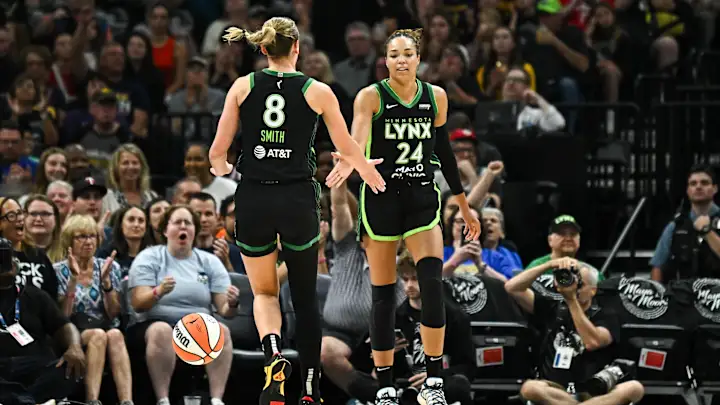In the quiet before the season, before the bright lights and roaring crowds, there is a sacred space few outsiders truly see.
It is not a space of celebration but of confrontation — of self against self, dream against doubt.
This space is called training camp, and for the women of the WNBA, it is where legends are not discovered but forged.
It is here, in the sweat-slicked gyms and grueling scrimmages of late April and early May, that careers are won, futures are shaped, and the full spirit of the league is laid bare.
The meaning of WNBA training camp is not merely practical — it is elemental.
It is the fire that tempers greatness, the gauntlet that separates potential from inevitability.
To understand the WNBA today, to understand its fierce, unbreakable beauty, you must understand the enduring, relentless power of training camp.
A Legacy Born in Competition
When the WNBA launched its first season in 1997, it did so under extraordinary pressure.
The league had to be great — immediately. It had to prove its viability in a market skeptical of women’s professional sports.
There was no luxury of time, no patience for slow growth. Excellence had to be visible from the very first tip-off.
Thus, training camp was never just a warm-up. From the beginning, it was a war of attrition, designed to cultivate only the most resilient, the most skilled, the most fiercely determined players.
The early camps — held in converted practice facilities and often overlooked by national media — were ferocious.
College All-Americans, Olympians, streetball legends, and overlooked dreamers collided headlong, each understanding there would be no participation trophies.
Every player who laced up for the inaugural WNBA season had one thing in common: they had survived the fire of training camp.
This tradition has never diminished.
If anything, as the league grew in talent, stature, and visibility, the stakes only intensified.
The Ritual of the Cut: Understanding the Brutality
WNBA training camp exists in stark contrast to most other professional sports leagues.
In the NBA, NFL, or MLB, a bad camp might mean a demotion, a benching, a chance to improve.
In the WNBA, a bad camp often means the end.
With only 11 or 12 roster spots per team (and stringent salary cap restrictions), the room for error is microscopic.
Every possession matters. Every drill is watched. Every scrimmage is a test.
Players aren’t just competing against others — they are competing against math itself.
By the end of camp, heartbreaking cuts are inevitable.
Players with championship experience, Olympic medals, or thousands of Instagram followers are not exempt.
And yet — it is precisely this brutality that gives WNBA training camp its enduring meaning.
There are no entitlements here.
No reputations immune from scrutiny.
Only the work matters. Only the present moment matters.
This reality, while cruel, forges something rare and magnificent: a league where every player has already been tested under conditions that would break most.
When you watch a WNBA game, you are not simply watching talent.
You are watching survivors of one of the most ruthless selection processes in sports.
Beyond Preparation: Camp as Cultural Bedrock
Training camp is often framed narrowly — as a preseason exercise to finalize rosters and implement strategies.
But for the WNBA, training camp serves a much larger, cultural function: it is the annual re-affirmation of the league’s identity.
The values the WNBA champions — resilience, community, innovation, defiance — are all distilled and dramatized within camp.
Consider the daily reality of camp:
- Veterans mentoring rookies even as they compete for the same roster spot.
- Coaches pushing players to exhaustion, not out of cruelty, but belief in their unseen potential.
- Teammates lifting each other up after brutal practices because they understand: no one climbs alone.
Training camp builds not just players but culture.
It reminds everyone, year after year, that this league was not built easily, and it will not be sustained easily.
It must be earned — again and again — in the trenches.
Case Studies: Legends Forged in Camp
Training camp’s power is not theoretical.
Over and over, the WNBA’s greatest stories trace their origins back to overlooked moments in camp.
Becky Hammon, passed over in the 1999 draft, earned a training camp invitation from the New York Liberty.
She made the roster. She went on to become a six-time All-Star, a champion coach, and a trailblazer for women in sports leadership.
Erica Wheeler, undrafted in 2013, bounced around teams on training camp contracts.
She fought her way into a roster, then into starting lineups, and ultimately into WNBA All-Star MVP honors.
Jonquel Jones, a number-six draft pick, was initially seen as a project player.
Through brutal early camps, she transformed into an MVP, a world champion, and one of the most versatile forwards the game has ever seen.
Behind every WNBA superstar is a history of battles won in the hidden wars of April.
The Fire Grows Hotter: Why Camp Is Tougher Than Ever
The WNBA of 2025 is not the league of 1997.
Today’s training camps are tougher, faster, and more consequential than ever before.
Why?
- The Globalization of Talent
Players now pour in from every corner of the globe — Australia, Spain, Nigeria, France, Japan.
The talent pool has never been deeper. The competition for spots, never fiercer. - The Evolution of Player Development
Modern players arrive with polished skills honed through elite college programs, overseas leagues, and advanced training methods.
Gone are the days when rookies could expect patience. Today, rookies must be impact players from day one. - The Rise of the “Positionless” Player
Teams now value versatility over specialization.
Players must be able to defend multiple positions, hit threes, and create offense.
Specialists — unless elite — find themselves edged out. - Economic and Roster Pressures
Salary cap dynamics often force teams to favor younger, cheaper players, intensifying the churn.
A single turnover can tip the balance between a contract and a plane ticket home.
In this environment, training camp is less a beginning than a battlefield.
Expansion and the Future: A New Dawn for Training Camp
Change, however, is coming.
The arrival of expansion teams in Toronto and Portland in 2026 promises to transform the WNBA landscape:
- More roster spots will be available.
- More players will get longer looks in camp.
- More dreams will have a fighting chance.
Expansion will not diminish the fire of training camp — it will spread it wider.
Players who might have been cut early in past years will now find homes.
Veterans squeezed out by cap math will reclaim opportunities.
International talent will surge in even greater numbers.
The meaning of training camp will evolve — from ruthless elimination to fierce cultivation.
The forge will remain — but it will welcome more into the flame.
The Enduring Meaning: Why the Forge Matters
At its core, training camp persists because it tells the truth about sport — and life itself.
It reminds us that greatness is never given.
It must be seized, and it must be sustained through courage, adaptability, and relentless work.
It reminds us that pain and beauty are inextricably linked.
The anguish of a roster cut is real. So too is the soaring joy of a dream achieved against impossible odds.
It reminds us that the WNBA is not just a league of stars but a league of survivors, builders, and believers.
In a world that often celebrates only the end results — championships, MVPs, endorsement deals — training camp honors the process.
It honors the grind, the sacrifice, the unseen hours, the heartbreak, the becoming.
This is why, as the WNBA storms into a future brighter than ever imagined, training camp remains its purest ritual.
Because here, in this crucible, legends are still being forged — one day, one drill, one dream at a time.
No comments yet.








